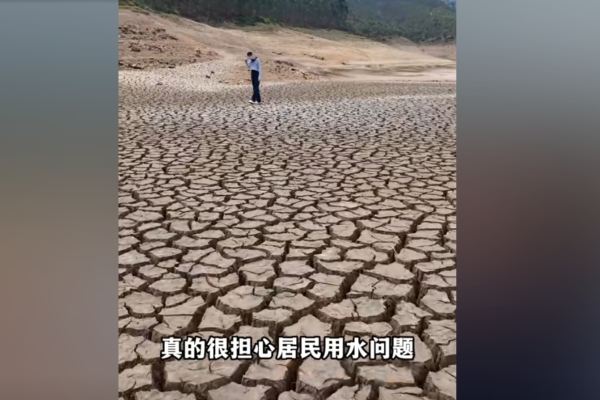In recent months since November 2024, some areas in Guangxi have been experiencing persistent drought, affecting not only local agricultural production but also causing difficulties in residents’ drinking water supply.
Recently, videos posted on social media by netizens in Guangxi showing dry farmlands and withered crops have attracted widespread attention. One video posted by a Guangxi netizen revealed that the drought had caused the reservoir to dry up, with rice fields severely cracked due to water shortage, and seedlings with yellow and curled leaves. Many farmers commented in the section that their own rice and sugarcane were unable to grow properly due to the drought.
According to the Guangxi Flood Control and Drought Relief Headquarters, the meteorological drought in Guangxi is currently severe. Monitoring results on April 17 showed that 97.5% of Guangxi’s meteorological area is experiencing drought, with a particularly severe area of 68.7%. The drought has affected drinking water for humans and animals, agricultural production, and increased the risk of forest fires, with certain towns facing water supply risks.
Statistics from the local meteorological bureau indicated that since November 2024, the average precipitation in Guangxi was 110.0 millimeters, nearly 70% less than usual for the same period, marking the lowest since 1961. The main drought areas are concentrated in the southern parts of Guilin, Liuzhou, as well as in Hechi, Baise, Hezhou, Laibin, Guigang, Nanning, Wuzhou, Yulin, and Qinzhou.
The Hydrological Center of the Guangxi Zhuang Autonomous Region predicts that the hydrological drought may continue until the end of April. On April 19 at 18:00, the Guangxi Water Resources Department initiated a Level Three emergency response to the drought.
Mr. Li from Nanning told reporters on April 21, “We have not experienced such a severe drought in so many years. It’s been seven months without any rainfall. From Nanning to Liuzhou, Guilin, all the way to the border with Vietnam, it’s all dry, especially Nanning, which is exceptionally dry.”
Guangxi is China’s largest sugarcane planting base and the main producer of sugar. Sugarcane fields cover about 60% of the national area.
Currently, sugarcane in Guangxi is in the stages of seeding and rooting, and the drought poses a serious threat to its growth. Mr. Li expressed that the drought has caused many plants, including sugarcane and rice, to wither, and if there continues to be no rainfall, this year’s food production may be significantly impacted, leading to higher prices.
Mr. Guo, a resident of Xingye County in Yulin City, located in the southeastern part of Guangxi, mentioned that two out of his three fish ponds have dried up, with the surrounding areas bare of grass. He described how even the nearby bamboo trees have shed all their leaves, leaving the ground cracked and difficult to walk on.
Due to the drought, residents in various regions of Guangxi are facing water scarcity. People in Chongzuo Fusui, Guigang, Dahua, Long’an, and Youjiang District have to queue for water. For instance, in Guigang Fangzhu Village, ponds have dried up, and villagers have to queue until dawn to fetch water for irrigation. In Chongzuo Fusui Changping Town, the water level in drinking water wells has dropped, making it impossible to draw water, causing difficulties for residents’ drinking water supply.
A villager from Changping Town told reporters that the drought is severe, with no substantial rainfall for months, resulting in dry rivers and communal wells running dry, making it difficult to access drinking water.
As reported by CCTV News, as of 9:00 on April 21, drought disasters have occurred in 52 counties (districts) in 11 cities in Guangxi, affecting 405,000 people, with 83,000 people (real-time 49,000 people) requiring assistance due to difficulties in accessing drinking water. The affected area of crops amounts to 51,300 hectares, resulting in direct economic losses of 210 million yuan.
Related Reports:
Persistent Drought in Guangxi: Fish Drying Up, Farmlands Cracked
Wildfires Spread Across Multiple Villages in Yulin, Guangxi, Putting Homes at Risk

